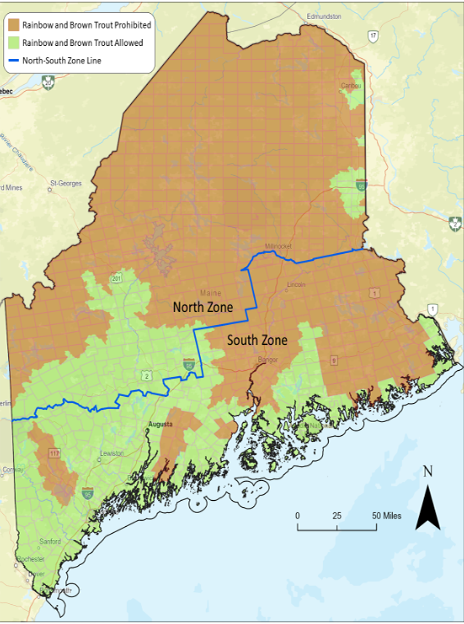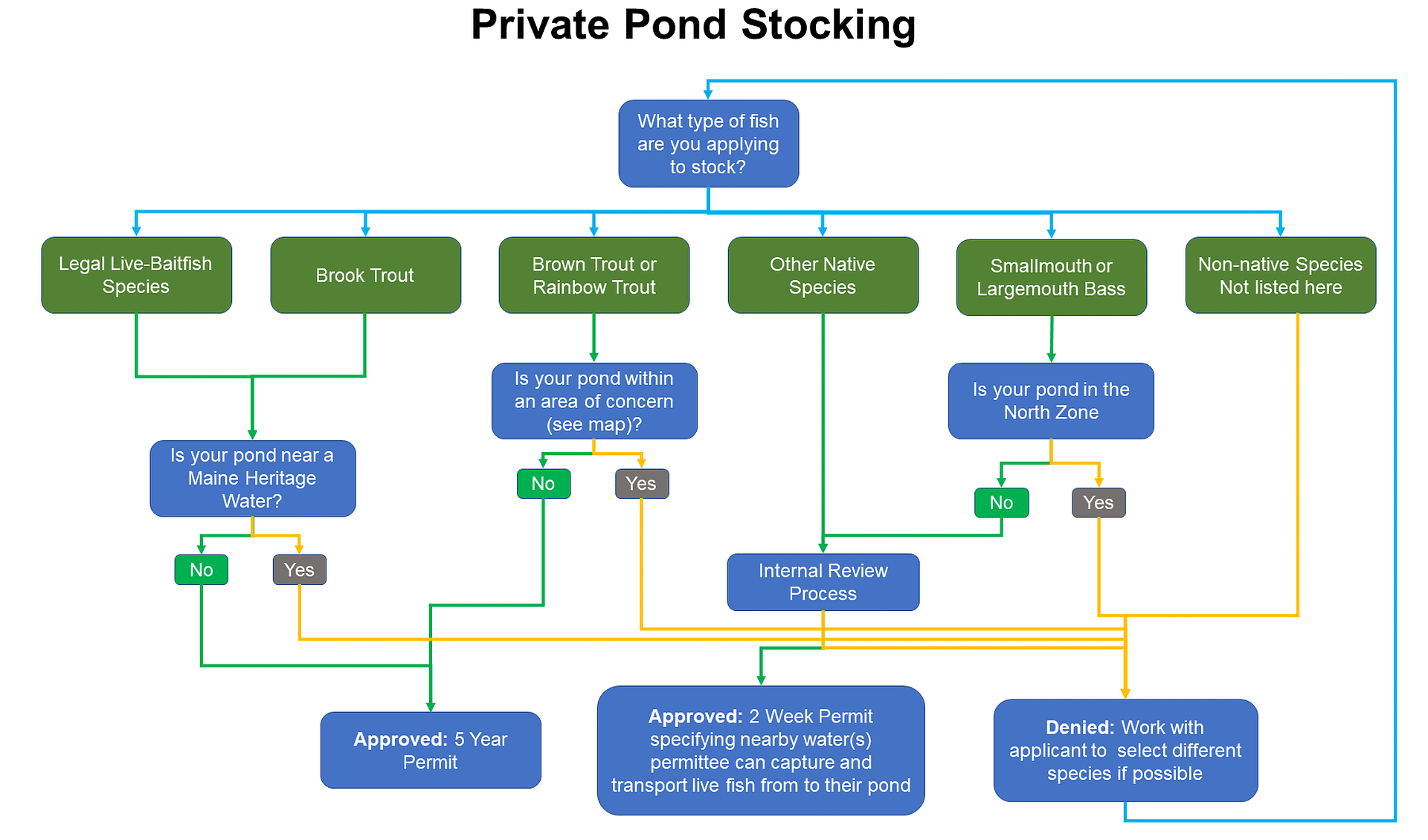Home → Fish & Wildlife → Fish and Wildlife in Captivity → Private Pond Fish Stocking
Private Pond Fish Stocking
Private Pond Management Information and Resources
Interest in private pond management appears to fall into a few categories; 1. Creating accessible private fishing opportunities, 2. Enhancing ecological function to benefit humans, fish, and wildlife, and 3. Remediating eutrophication related to increases in water temperature and nutrients. These goals often coincide and with some initial research, permitting, and physical labor, pond owners can create fishing opportunities, benefit wildlife, and reduce algae and mosquitoes. This information is intended to provide you with some background, basic information, and areas of interest to research further. This is not intended to be a comprehensive guide to private pond management.
Introducing fish to new waterbodies poses inherent risks that can be mitigated with considerate legal fish stocking.
A permit is required to stock any private pond with fish or baitfish. Please read on to learn about the permitting process, legal species, and more.
Application to Stock Waters in the State of Maine (PDF)
Frequently Asked Questions
What is a private pond?
The simplified definition of a "private pond" means:
- An artificially constructed pond impounded within the limits of a single owner*,
- that is not formed on a brook, river, or stream,
- and is less than 10 acres in size.
*In instances where pond ownership is shared, pond stocking permits require written consent of all affected landowners.
How do I legally stock my private pond?
All private pond stocking must be permitted. Fill out and submit the Application to Stock Waters in the State of Maine (PDF). Several considerations govern the stocking of private ponds including:
- impacts to the water supplies used by public and private aquaculture facilities,
- potential movement of diseases, parasites, or aquatic invasive fish and wildlife,
- interference with fisheries management programs,
- the prohibition of stocking by law in certain areas,
- and the potential impact stocked fish may have on native self-sustaining populations
What species of fish am I allowed to stock in my private pond?

The importation of live fish and eggs from outside of Maine is illegal without an importation permit (PDF). Though this importation permit exists, it has rarely been issued, and requires a thorough health evaluation of the fish or eggs being imported. Private pond owners are effectively limited to fish sourced from within Maine's borders (Table 1). The ban on interstate fish importation has undoubtedly limited the spread of aquatic invasive species and diseases in Maine.
Legal live baitfish species may be stocked throughout the state, except where they could impact a Heritage Water, with the approved appropriate stocking permit. Legal baitfish can be obtained from hundreds of Maine licensed commercial bait retailers. With the exception of Rainbow Smelt (Osmerus mordax) and American Eel (Anguilla rostrata), which require special licensing and have their own regulations, you may capture baitfish yourself using minnow traps with a recreational fishing license. Just ensure that you are able to identify the fish you capture. We also highly recommend obtaining fish sourced as locally as possible to limit the spread of aquatic invasive species.
Commercial sources of sportfish are limited to commercially licensed Maine hatcheries. Maine's commercial hatcheries currently produce the cold-water salmonid species Brook Trout (Salvelinus fontinalis), Brown Trout (Salmo trutta), and Rainbow Trout (Oncorhynchus mykiss). Brook Trout from a licensed hatchery are by far the most commonly stocked species in the state. If your pond does not have the potential to allow fish to enter a Heritage Water, should flood or failure occur, then Brook Trout can typically be stocked. Unfortunately, Brook Trout are not suitable for every pond as they tend to be more sensitive to water quality factors than Brown and Rainbow Trout. The areas of Maine where Brown and Rainbow Trout may be stocked are more limited than Brook Trout, as neither species is allowed where there is a concern of feral populations establishing and negatively impacting existing native fisheries (See Map).
If your pond is too warm for trout and you still want sportfish, or you simply want other species, you can apply for a permit. Approved permits for unlisted species simply act as a transfer permit allowing you to catch fish, following contemporary fishing regulations, keep them alive and transfer them to your private pond. Unlike the above permits that are valid for five years, these transfer stocking permits only grant up to a two-week window to capture and transport the fish. Applications are highly scrutinized because these fish transfers could affect public resources. These permits are, therefore, generally more difficult to obtain. If agency staff have concerns about the potential escape of the species during transport or from your pond, the permit will not be issued. If approved, staff will work with you to select the waters you're allowed to capture fish from and the time period you may transfer them. Typical options for native warmwater sportfish are Pumpkinseed Sunfish (Lepomis gibbosus), Redbreast Sunfish (Lepomis auritus), Chain Pickerel (Esox niger), White Perch (Morone americana), Brown Bullhead (Ameiurus nebulosus), and Yellow Perch (Perca flavescens). The stocking of Smallmouth (Micropterus dolomieu) and Largemouth Bass (Micropterus salmoides) is only allowed in certain areas of the South Zone where they have naturalized and are managed as a sportfish.
Without exception, fish species considered invasive (e.g., entire state; Black Crappie, Bluegill, Northern Pike, Muskellunge, Green Sunfish: North Zone; Smallmouth and Largemouth Bass) by MDIFW cannot legally be stocked into private ponds. Introducing fish without a valid permit is a Class E crime subject to a fine of up to $10,000.
| Species/Group | Areas Allowed | Permit Duration | Source of Fish |
|---|---|---|---|
| Legal Live Baitfish | Restricted to areas where escapement would not affect Heritage Waters or other significant resources | 5 Years | Maine licensed retailers; Maine licensed non-commercial harvest |
| Brook Trout | Restricted to areas where escapement would not affect Heritage Waters or other significant resources | 5 Years | Maine licensed commercial hatcheries |
| Brown and Rainbow Trout | Restricted to areas where escapement is unlikely to affect wild native salmonids | 5 Years | Maine licensed commercial hatcheries |
| Smallmouth and Largemouth Bass | Restricted to certain areas in the South Zone that already contain naturalized populations with case-by-case review | Up to 2 Weeks | Angling from specified water(s) near the pond location |
| Native Warmwater Sportfish* | Entire State with case-by-case review | Up to 2 Weeks | Angling from specified water(s) near the pond location |
| Non-native species not listed here | NOT ALLOWED | ||
| Any fish or eggs from outside of Maine | NOT ALLOWED |
*Maine's native warmwater sportfish include Pumpkinseed Sunfish (Lepomis gibbosus), Redbreast Sunfish (Lepomis auritus), Chain Pickerel (Esox niger), White Perch (Morone americana), Brown Bullhead (Ameiurus nebulosus), and Yellow Perch (Perca flavescens).
What species of fish should I stock in my pond?
What species you put in your pond not only depends on what is allowed in your area, but also on your private pond management goals, the pond's water quality and physical characteristics. Many private ponds in Maine do support Brook Trout (PDF). If your pond becomes too warm in the summer to support year-round trout survival, then you may consider some of our native warmwater sportfish like Pumpkinseed Sunfish (Lepomis gibbosus) or White Perch (Morone americana). If you would simply like fish to attract piscivorous wildlife, then legal baitfish alone may suit your needs. Golden Shiner (Notemigonus crysoleucas) are widely available from licensed bait retailers and can be found in many waters throughout the state. They can also grow rather large, are very tolerant of different water conditions, and should require little/no maintenance.
My pond doesn't drain anywhere, so why are there restrictions on the species I can stock?
There are private ponds where the threat of fish escaping is low, but extreme events like flash floods and hurricanes could still allow fish to escape from most ponds. There will always exist a risk of fish from a private pond negatively affecting a public resource. That risk must be mitigated while providing legal stocking opportunities.
How do I control mosquitos in my pond?
The best way to control mosquitos is by agitating the water's surface with aerators, bubblers, and water features. Mosquitos will not lay eggs in moving water. This also has the added benefit of increasing oxygen in the water that will benefit the aquatic animals, like fish, in your pond.
Almost all fish species will eat mosquito larvae. Though it's generally dependent on the fish's size and food availability. For example, it's unlikely that a 16" bass will feed on mosquito larvae if there are an abundance of minnows available, but a 2" bass may target the mosquitos. One native fish that specializes in eating invertebrates near the water surface, the Banded Killifish (Fundulus diaphanus), will eat many mosquito larvae, doesn't get very large, is good forage for larger game fish, and is a legal live baitfish.
How do I control the algae in my pond?
Algal blooms are caused by excess nutrients, generally phosphorus and nitrogen. To reduce algae, you need to reduce nutrients entering the pond and have more desirable organisms in place to use available nutrients. Limiting the application of fertilizers and a buffer of plants around the pond will reduce nutrients entering the water. Many of our native plants can act as a nutrient sponge along the margins of ponds. Native willows, like Black (Salix nigra) and Shining Willow (Salix lucida), are generally easy to establish by simply sticking cuttings into the wet soil or mud. Other examples of attractive native plants that also benefit wildlife you may want to consider are Buttonbush (Cephalanthus occidentalis), Cardinal Flower (Lobelia cardinalis), Broadleaf Arrowhead (Sagittaria latifolia), Pickerelweed (Pontederia cordata), and Broadleaf Cattail (Typha latifolia). These plants are available from many vendors but using nurseries specialized in raising native plants for ecological remediation should be used to reduce the chances of invasive hitchhikers. Regardless of the source, plants should be thoroughly rinsed and inspected for pieces of other plants clinging to them since many of the worst invasive plants can spread from a tiny fragment.
There are chemicals that sequester nutrients and dyes that limit light penetration into the water. However, these methods do not fix the problem, generally require indefinite reapplication, and are not recommended as a permanent solution.
What do I need to do to construct a private pond on my property?
The University of Maine's Cooperative Extension has good summary information on constructing a private pond. Ultimately, pond construction may be regulated by Maine's Department of Environmental Protection, Land Use Planning Commission, and local town ordinances.
